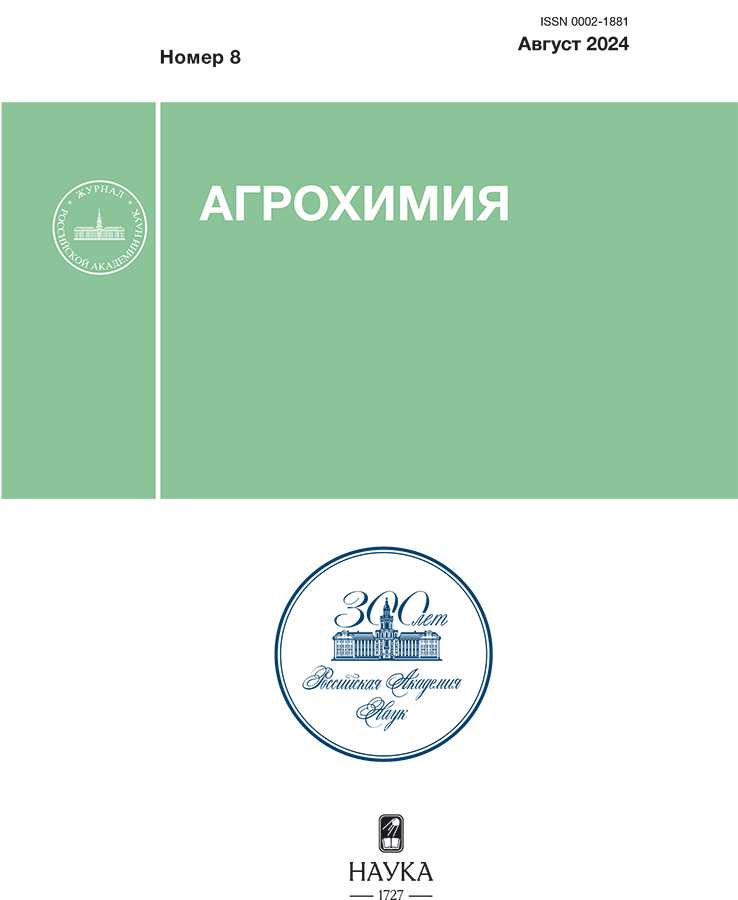Управление продуктивностью льна-долгунца путем оптимизации минерального питания
- Авторы: Сорокина О.Ю.1
-
Учреждения:
- Федеральный научный центр лубяных культур
- Выпуск: № 8 (2024)
- Страницы: 42-49
- Раздел: Удобрения
- URL: https://kld-journal.fedlab.ru/0002-1881/article/view/647200
- DOI: https://doi.org/10.31857/S0002188124080067
- EDN: https://elibrary.ru/cdwwll
- ID: 647200
Цитировать
Полный текст
Аннотация
В Тверской обл. на дерново-подзолистой легкосуглинистой почве изучили управление продуктивностью разных по срокам созревания сортов льна-долгунца (Зарянка и Дипломат) путем оптимизации их минерального питания. Для расчета дозы минерального питания использовали 3 способа: балансовый, модифицированный Каюмовым, балансовый на компенсацию выноса и по соотношению элементов в удобрении. Соответственно дозы составили N0P0K0 (контроль), N30P0K50, N30P22K80, N30P60K150. Установлено, что несмотря на различные погодные условия, применение удобрений с начальных фаз роста растений льна позволило растениям накапливать бóльшую биомассу: в засушливых условиях в среднем для сортов больше на 58%, в оптимальных условиях водообеспечения – на 45%. Поглощение элементов питания растениями льна-долгунца возрастало с увеличением дозы внесенных элементов. При равной дозе азота в удобрении его количество было больше как в корнях, так и стеблях льна, при увеличении доз фосфора и калия в удобрении. Содержание азота, фосфора и калия в корнях льна позднеспелого сорта Дипломат было больше, чем раннеспелого Зарянка. При оптимизации питания за счет внесения удобрений в дозах N30P22K80 и N30P60K150 доля стеблей в структуре растений льна увеличивалась и составляла у сорта Зарянка 45 и 46%, у сорта Дипломат – 44 и 49% соответственно дозам. Без удобрений доля стебля составила 38%, а доля корней и листьев была самая высокой – 22 и 42%. Продукционный процесс в этом случае был менее рациональный. Позднеспелый сорт Дипломат в среднем за 3 года при внесении всех доз удобрений имел урожайность льносоломы больше на 3.1–3.9 ц/га, чем раннеспелый сорт Зарянка. У раннеспелого сорта Зарянка более высокая доза удобрений N30P60K150 снижала показатели качества: номер длинного волокна и процентономер всего волокна, особенно в засушливый вегетационный период.
Ключевые слова
Полный текст
Об авторах
О. Ю. Сорокина
Федеральный научный центр лубяных культур
Автор, ответственный за переписку.
Email: olga-sorokina@bk.ru
Россия, 170041 Тверь, Комсомольский просп., 17/56
Список литературы
- Черников В.Г., Ростовцев Р.А., Кудрявцев Н.А., Ущаповский И.В., Попов Р.А., Скворцов С.С. Влияние факторов окружающей среды на урожай и качество льняного сырья // Вестн. аграрн. науки. 2020. № 5(86). С. 3–10.
- Система оценки влияния агрохимических факторов на формирование урожайности льна-долгунца. М.: ВНИИА, 2016. 124 с.
- Белоусова Е.Г., Спиридонов А.В., Титова В.И. Влияние удобрений на урожайность льна и качество льнопродукции при выращивании его на светло-серой лесной легкосуглинистой почве // Международ. сел.-хоз. журн. 2019. № 1(367). С. 32–35.
- Гаврилова А.Ю., Конова А.М. Урожайность льна-долгунца и качество волокна в зависимости от возрастающих доз минеральных удобрений // Вестн. Ульяновск. ГСХА. 2022. № 2(58). С. 52–59.
- Кузьменко Н.Н., Сухопалова Т.П., Ильина В.И. Влияние агротехнологических элементов возделывания на продукционный процесс льна-долгунца // Перм. аграрн. вестн. 2019. № 1. С. 48–54.
- Gupta M., Kour S., Gupta V., Bharat R., Sharma C. Effect of different doses of fertilizers in yield and NPK uptake of linseed (Linum usitatissimum L.) // Bangladesh J. Bot. 2017. V. 46(2). P. 575–581.
- Понажев В.П., Медведева О.В. Современные достижения селекции и семеноводства для выращивания льна // Достиж. науки и техню АПК. 2015. Т. 29. № 9. С. 36–39.
- Карпунин Б.Ф. Прогнозирование структуры урожая у льна-долгунца для применения в точном земледелии // Земледелие. 2016. № 1. С. 5–7.
- Носевич М.А., Новохацкая Д.М. Урожай и качество волокна льна-долгунца в зависимости от сортовых особенностей, норм высева и применения биопрепаратов // Плодородие. 2015. № 6. С. 24–27.
- Ториков В.Е., Шаков В.М., Романова И.Н. Эффективность агроприемов возделывания новых сортов льна-долгунца на юго-западе Нечерноземья России // Вестн. Ижевск. ГСХА. 2016. № 2. С. 16–25.
- Сорокина О.Ю. Оценка ассортимента удобрений и способов их внесения под новый сорт льна-долгунца Универсал // Аграрн. наука. 2021. № 6(350). С. 55–59.
- Практикум по агрохимии: Учеб. пособ. / Под ред. В.Г. Минеева. 2-е изд., перераб. и доп. М.: Изд-во МГУ, 2001. 689 с.
- Каюмов М.К. Программирование урожаев сельскохозяйственных культур. М.: Агропромиздат, 1989. 56 с.
- Тихомирова В.Я., Сорокина О.Ю., Кузьменко Н.Н., Нечушкин С.М. Усовершенствованная система применения удобрений в льняном севообороте. Торжок: ООО “Фирма Вариант”, 2005. С. 14–16.
- Тихомирова В.Я., Сорокина О.Ю. Лен-долгунец. Биологические особенности. Управление формированием урожая и его качество: научн. изд-е. Тверь: Тверь. гос. ун-т, 2011. С. 100–101.
- Golub I.A., Blokhina I.N. Reaction of Belarusian and French fiber flax samples on nitrogen doses along the duration of the growing season, yield of seeds and fiber // Crop Farm. Plant Grow. 2020. V. 2. P. 52–55.
- Кошелева Л.Л. Физиология питания и продуктивность льна-долгунца. Минск: Наука и техника, 1980. 200 с.
- Методические указания по проведению агрохимических исследований со льном-долгунцом. М.: Типография ВАСХНИЛ, 1972. 49 с.
- ГОСТ 14897-69 Солома льняная. Изд-е офиц. М.: Изд-во стандартов, 1979. 16 с.
- Методические указания по проведению технологической оценки льносоломы и опытов по первичной обработке льна. Торжок: ВНИИЛ, 1972. 38 с.
- Сорокина О.Ю. Продуктивность льна-долгунца в зависимости от метеоусловий, удобрений и сорта // Агрохим. вестн. 2022. № 3. С. 23–27.
Дополнительные файлы














